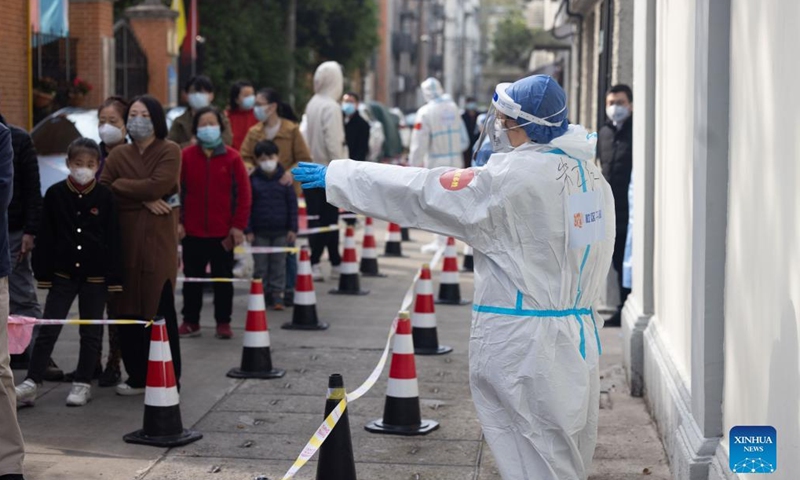
Only a few people walk along the normally bustling Nanjing Road pedestrian street in Shanghai on March 29, 2022 as the city battles an ongoing COVID-19 outbreak. Photo: Wu Chuanhua/Global Times
The Chinese mainland discovered 103,965 local COVID-19 infections in March in 29 provincial-level regions, national health officials revealed on Friday at a press conference, while stressing that China will firmly uphold the dynamic-zero COVID-19 strategy facing the current complex and severe situation, and the country is still able to achieve that goal.
Among the 29 affected regions, Northeast China's Jilin Province reported more than 44,000 cases and East China's Shanghai more than 36,000 cases, Lei Zhenglong, a senior official with China's National Health Commission (NHC), said at the press conference. Cases discovered in the two places account for about 90 percent of the total cases discovered recently.
Community transmission has not been cut in the cities of Jilin and Changchun of Jilin Province. And the epidemic in Shanghai is rapidly surging and has expanded to some other provinces. The infections in Shanghai are still expected to increase, Lei noted.
According to the NHC, a total of 1,787 domestic cases were discovered in China on Thursday with 1,363 in Jilin Province and 358 in Shanghai. There were also 5,559 silent virus cases discovered on Thursday with 4,144 in Shanghai and 871 in Jilin.
There were 29,306 existing COVID-19 cases in China as of Thursday, according to the NHC.
There are no signs of a significant decline trend in this round of the Omicron outbreak, a Beijing-based respiratory expert told the Global Times on the condition of anonymity on Friday. But he noted that it's not our goal to see an inflection point. When the inflection point comes will reflect the effectiveness of the preventive and control measures.
China is facing a complex and severe epidemic situation, Mi Feng, a spokesperson from the NHC, noted at the Friday press conference. Mi called for coordination among different regions and serious monitoring of high-risk groups to curb the spread of the virus as soon as possible.
Wu Zunyou, chief epidemiologist with the Chinese Center for Disease Control and Prevention, agreed that China must adhere to the dynamic zero-COVID approach.
The Omicron BA.2 sub-variant spreads rapidly and will infect many people in a short time. It can still cause severe peril to a country or region, Wu explained at the press conference.
China's COVID-19 prevention and control practice has proven that the dynamic zero-COVID approach is still the most economical and effective strategy for COVID-19 control, said Wu.
"Based on the experience accumulated from the past two years and our understanding of the virus' mutations, I believe China is still able to realize the dynamic zero-case of COVID-19, Wu noted.
"China still has the condition and will continue to focus on dynamic zero-COVID policy as the Western-like 'lie flat' will cause many problems such as medical resources squeezing and rising fatalities," the expert said. The current low fatality rate of COVID-19 is on the basis of effective preventive and control measures, he noted.
A new mutant strain of the novel coronavirus called XE has been discovered in the UK leading to at least 637 cases as of late March, the UK authority revealed.
XE is a blend of two Omicron strains. It has shown a variable growth rate but UK scientists said that they cannot yet confirm whether it has a true growth advantage. So far, there is not enough evidence to draw conclusions about transmissibility, severity or vaccine effectiveness, according to the UK government.
Chinese experts reached by the Global Times try to ease public concerns over the XE variant, saying that as neither the WHO nor the UK has listed it as variants of concern (VOC) or variants under investigation (VUI), it means that XE is not that threatening at current. It is fine as long as scientists keep a close eye on it.
But, as a whole, the WHO expects COVID-19 to become less severe over time.
"Based on what we know, the most likely scenario is that the COVID-19 virus will continue to evolve, but the severity will be reduced over time as immunity increases due to vaccinations and infections," Tedros Adhanom Ghebreyesus, WHO's director-general, said at a press briefing on Wednesday.

Community workers guide local residents to do nucleic acid test in Changning District of east China's Shanghai, April 1, 2022. Shanghai has launched a nucleic acid testing campaign in areas west of the Huangpu River from Friday amid the second phase of the city's closed-off management.Photo:Xinhua
A primary conclusion based on current research is that the following mutations would be more infectious than the BA.2 variant. But it is still hard to accurately predict its virulence, which will pose a challenge to anti-epidemic measures in the future, said Zhuang Shilihe, a Guangzhou-based expert.
Faced with the uncertainty of the mutations, Chinese experts noted the necessity to get boosters and accelerate the development and research on drugs.
Over 1.24 billion people have been fully vaccinated against the COVID-19 in China as of Thursday, accounting for 88 percent of the total population. Among vaccinated residents, over 212 million people above 60 years old have completed their full vaccination, national health authorities announced at the Friday press conference.
As to the problem that more asymptomatic carriers probably would occur when the virus transmits faster while causes less severe diseases, Wu noted that big data and an updated monitoring model, combining antigen screening with nucleic acid testing, can help find asymptomatic carriers early and cut the transmission chain.





